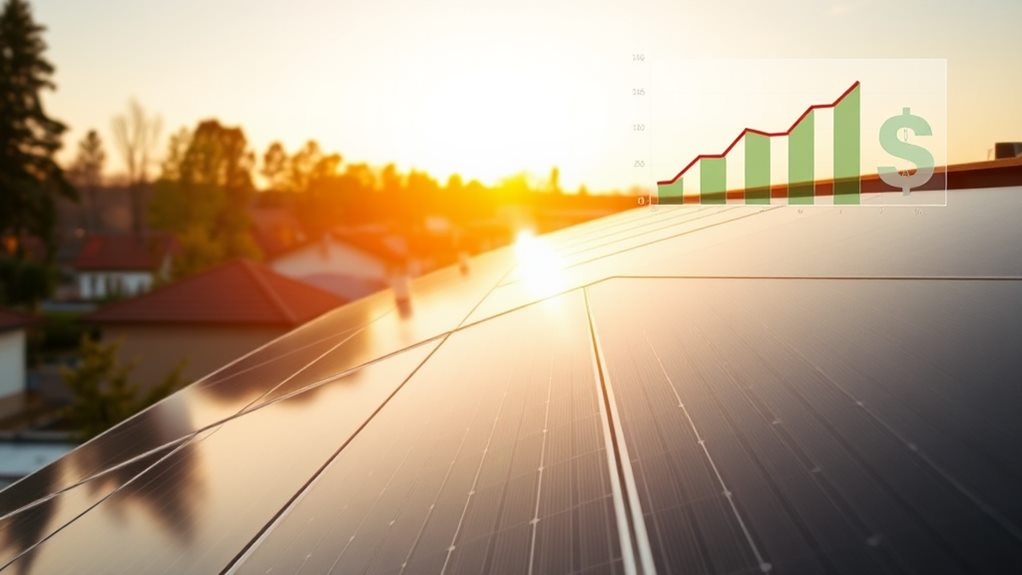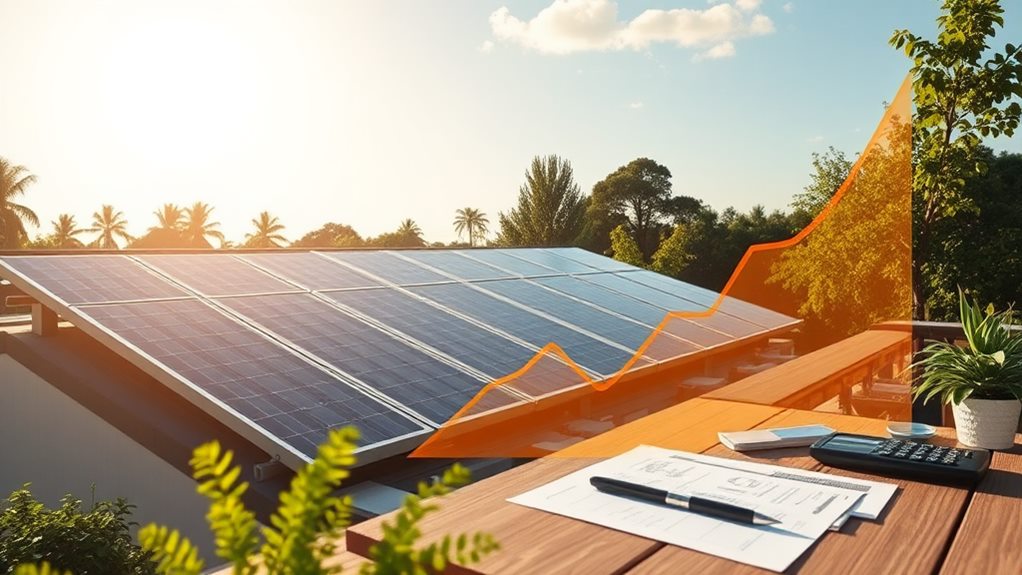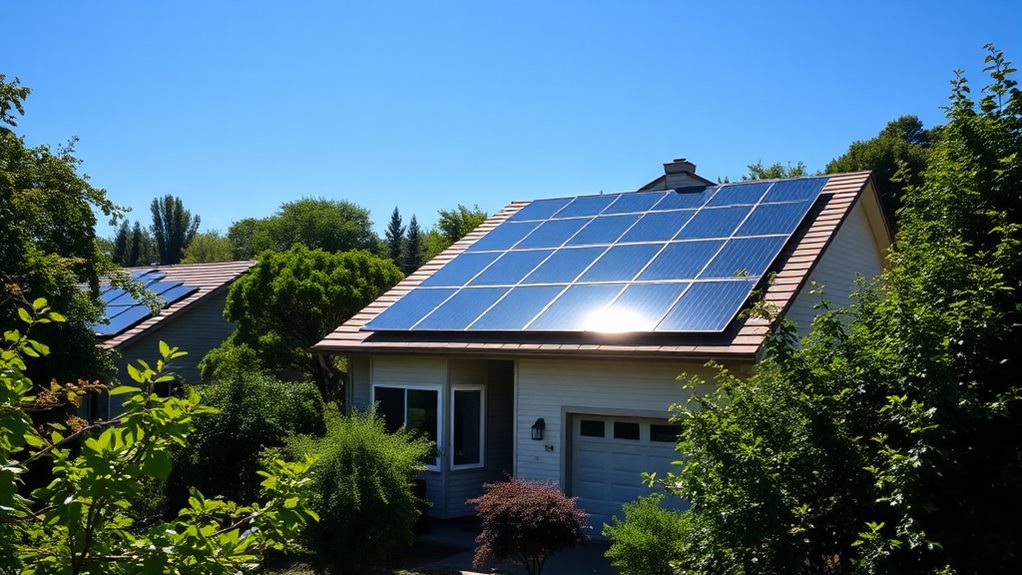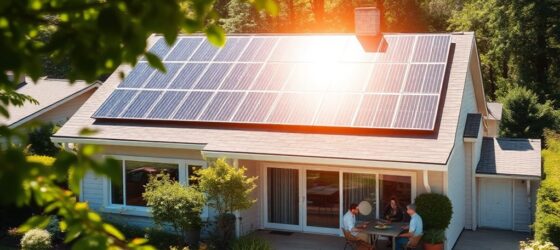To install affordable solar systems for your home, start by evaluating your energy needs and researching different solar panel types. The average cost for a 5-kW system is around $18,073, but financial incentives, including a 30% federal tax credit, can greatly lower this expense. It's wise to obtain at least three quotes from various installers to compare pricing and services effectively. Consider community solar programs if installation isn't feasible for you. Also, explore lease agreements or power purchase agreements (PPAs) as alternatives to outright purchase. Continued inquiry will reveal even more strategies and options for savings and efficiency.
Understanding Solar System Costs

When considering a solar system for your home, it's important to understand the costs involved. The national average cost for a 5-kW solar system is around $18,073, with solar panels cost averaging about $3.60 per watt. However, this can vary based on the types of solar panels you choose and your location.
In Texas, for instance, the average cash cost reaches approximately $27,991 but drops to about $19,594 after applying the federal tax credit of 30%.
Installation costs also play a significant role in the overall expenses. Local state incentives and rebates can further reduce your total investment, making solar energy more accessible.
When you factor in energy savings, homeowners can expect to save an estimated $89,425 over 25 years, with a typical payback period of around six years.
To maximize your investment, it's vital to assess your energy needs and explore different types of solar panels. By understanding the average costs, federal tax credit, and available state incentives, you can make an informed decision, ensuring your solar system meets both your budget and energy requirements effectively.
Comparing Installation Quotes
After understanding the costs associated with solar systems, the next step is to compare installation quotes from various providers. Obtaining at least three proposals from different solar installers will allow you to effectively evaluate pricing and installation quality.
Keep in mind that utilizing platforms like EnergySage Marketplace can provide transparent pricing and effective quote comparisons. When comparing quotes, consider the following key factors:
- Total cost: Look beyond the upfront price to determine long-term value.
- Price matching guarantees: Some solar installation companies, like Tesla Solar and Momentum Solar, offer these to help lower expenses.
- Online reviews: Check customer experiences to gauge the reputation of different installers.
- Detailed breakdowns: Ascertain you receive written quotes with clear itemizations of costs and services.
This thorough comparison empowers you to make informed decisions. Focus on the total cost, which encompasses both equipment and installation.
Having all quotes in writing facilitates better negotiation with potential installers, ensuring clarity about expectations. By being diligent in your comparisons and leveraging customer feedback, you'll find a solar installer that meets your needs while maximizing your savings.
Don't rush this process; a little extra effort now can lead to significant benefits down the road.
Exploring Financial Incentives

Many homeowners overlook the financial incentives available for solar installations, which can greatly reduce your overall costs. One of the most notable incentives you can take advantage of is the federal residential energy tax credit, offering a 30% tax deduction on solar panel systems. This investment tax credit can greatly decrease your solar installation costs, making it a smart financial decision.
Additionally, switching to solar energy can lead to long-term savings on utility bills, further enhancing the financial benefits of your investment notable savings over time.
In addition to federal incentives, many state and local programs provide further savings through rebates or grants. For example, certain local programs in Texas can offer up to $3,000 in savings.
To discover state-specific incentives, the North Carolina State University's DSIRE database is an invaluable resource.
If you're considering installing solar, you should also explore community solar programs. These programs allow you to subscribe to local solar projects, enabling you to benefit from solar energy without needing rooftop installations.
Furthermore, low-income households might qualify for government programs that offer free solar installations, thanks to initiatives stemming from the Inflation Reduction Act.
Community Solar Options
For homeowners seeking renewable energy solutions, community solar options present a flexible and cost-effective alternative to traditional rooftop installations. Since only about 25% of individuals can install solar panels on their roofs, these programs allow you to subscribe to local solar arrays, enabling you to benefit from renewable energy without the upfront costs typically associated with traditional installations.
Upper Solar's commitment to customer satisfaction guarantees that you'll find a solution that meets your needs.
Here are some key advantages of community solar programs:
- Cost savings on your electricity bills through bill credits.
- Access to renewable energy for those unable to install panels directly.
- Opportunities for bulk purchasing agreements, leading to reduced installation costs.
- Contribution to local economies by promoting sustainable energy practices and creating jobs.
Approximately half of U.S. states now offer community solar options, making it easier for participants to engage with renewable energy initiatives.
Evaluating Solar Leases and PPAs

Community solar options provide a great way to access renewable energy without the hassles of installation, but if you're considering a more direct approach to solar power for your home, evaluating solar leases and Power Purchase Agreements (PPAs) is a smart next step.
Solar leases allow you to harness solar energy without upfront costs by leasing the solar array from a company, which retains ownership during the lease term. Alternatively, PPAs involve you paying for the electricity generated at a predetermined rate, typically lower than your local utility rates, without any initial investment.
With affordable solar panel installation services, these options can be even more accessible, helping you shift to renewable energy seamlessly.
Both options generally span 20-25 years, offering long-term energy savings. However, it's essential to be aware of potential hidden fees that can arise in lease or PPA agreements, especially those that promise free solar panels.
While both solar leases and PPAs can ease financial burdens for those unable to afford the initial costs of solar installation, you should carefully read the terms. Some agreements may contain escalator clauses that increase costs if energy prices fall.
Thoroughly evaluating these agreements can guarantee you make an informed decision, maximizing your benefits from renewable energy.
Final Thoughts
To sum up, investing in an affordable solar system for your home can be as transformative as planting a seed that grows into a flourishing tree. By understanding costs, comparing installation quotes, and exploring financial incentives, you empower yourself to make informed decisions. Community solar options and evaluating solar leases or Power Purchase Agreements (PPAs) further enhance your choices. With the right approach, you can harness the sun's energy, reducing your bills while contributing to a sustainable future.


Recent Comments